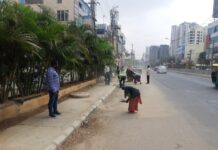
Kolkata, After a fascinating start, the Durga Puja spirit soared on Tuesday which marked Maha Saptami — day two of the Puja — as thousands of revellers, donned in their best, hit the streets across West Bengal.
The day started off with morning prayers, as the rituals commenced with “pran pratishtha” where the deity was symbolically endowed with life and invoked in a group of nine plants bunched together — the ‘Navapatrika’.
The “Kola Bou”, a tender banana plant symbolising a bride, was given a river bath amidst drum beats, wrapped in a sari and placed next to the idol of Ganesha.
Through “pran pratishtha”, the spirit of Durga as a warrior goddess is awakened, and she starts her battle against the manifestation of all evils in the form of Mahishasura — the buffalo demon.
In accordance with custom, fasting devotees offered flowers to the goddess in obeisance and later gorged on an array of delicacies.
People from the metropolis, the Bengal villages, other parts of India as also various countries walked shoulder to shoulder, paying obeisance to the goddess and watching in awe the colossal marquees – many of them beautiful work of art – on Maha Saptami (the seventh Lunar day).
They danced, whistled, mingled with friends and family and patiently stood in long queues before the landmark marquees. People flooded the innovative marquees with family in tow.
Bells chimed, cymbals clanged and the invigorating beats of “dhaak” (drums) set the evening for celebrations. This is also the time when people meet friends and family, relish the array of street food being sold in makeshift stalls.
Amid the passion to beat one another and the healthy competition, marquees both big and small, are there to captivate spectators. Traditional pujas usually have medium-sized idols within one frame (“ek chala”) and are decorated beautifully with “daker saaj” made from the pith of a plant, also called shoal.
The five-day carnival is the biggest annual event in this part of the world as roads are choked with human traffic throughout day and night.
The pujas at the houses of erstwhile zamindar (landowner) families of Hatkhola’s Duttas, the Devs of Shovabazar in North Kolkata and Mullicks of South Kolkata’s Bhowanipore also drew a steady stream of onlookers.
According to Hindu mythology, the festivities and prayers begin with the symbolic arrival of the goddess on earth on the sixth day of the first quarter of the moon and ends on Dashami or the 10th day, which is celebrated across the country as Dussehra.
Traditionally, every pandal has an idol of Goddess Durga depicting her as slaying the demon Mahishasur. She is shown astride a lion and wielding an array of weapons in her arms.








